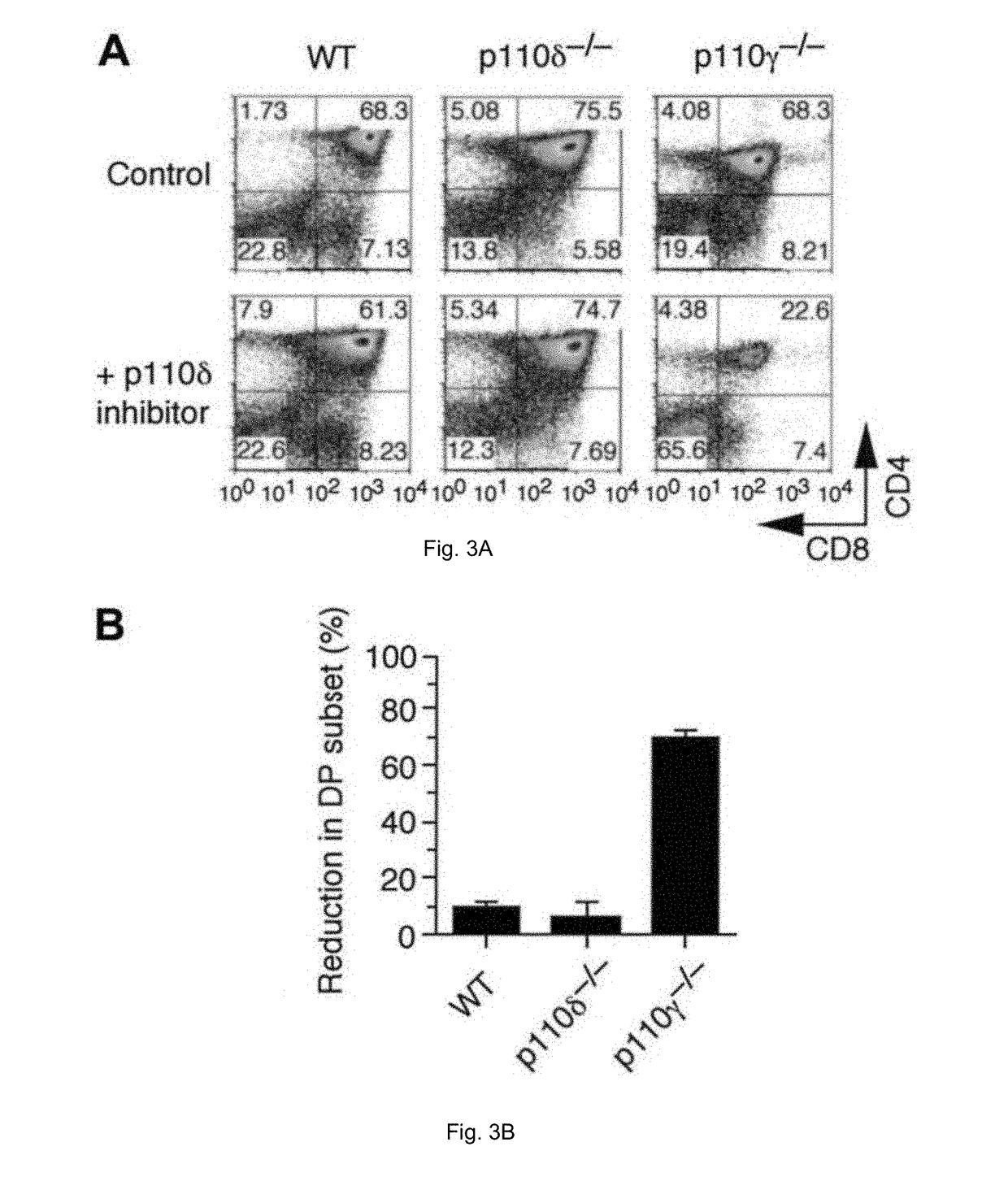Methods and Pharmaceutical Compositions for Treating Lymphoid Malignancy
a technology of lymphoid malignancy and compositions, applied in the direction of heterocyclic compound active ingredients, instruments, transferases, etc., can solve the problem of limited information regarding the role of pi3k in thymocyte survival, and achieve the effect of lowering tumor burden
- Summary
- Abstract
- Description
- Claims
- Application Information
AI Technical Summary
Benefits of technology
Problems solved by technology
Method used
Image
Examples
example 1
Materials and Methods
Mice and Animal Procedures.
[0115]All mice were kept in a specific pathogen-free facility at Columbia University Medical Center. All mice studies and breeding were carried out under the approval of the Institutional Animal Care and Use Committee of Columbia University.
[0116]Mice (p110δ− / − and p110γ− / −) on a mixed B6 / 129 background were described previously (Sasaki et al., 2000; Clayton et al., 2002). Animals were bred to generate a deficiency in both p110 catalytic subunits, the p110γδ− / − mice. Other names for the mouse include p110γδko and Pik3cg− / −; Pik3cd− / −, because p110γ is encoded by Pik3cg and p110δ is encoded by Pik3cd.
[0117]NOD.Cg-Prkdcscid II2rgtm1 WjI / Sz mice for xenograft experiments and Gt(ROSA)26Sortm1(Luc)Kael / J for bioimaging studies were obtained from The Jackson Laboratory (Bar Harbor, Me.). Mice deficient for PTEN in the T cell lineage were generated by crossing Lck-cre with floxed Pten (Hennet et al., 1995; Trotman et al., 2003). P110γ− / − and ...
example 2
Abnormal Thymus Size and Structure in p110γδ− / − Mice
[0152]The absence of p110δ and p110γ catalytic subunits in 4-week-old mice resulted in a significant reduction in thymus size compared with either age-matched WT littermate controls (FIG. 1Ai-ii) or singly deficient animals (FIG. 7). Consequently, total cell counts in p110γδ− / − thymi were significantly reduced compared with WT control (approximately 27-fold) or p110γ-deficient (approximately 10-fold) animals. No defect in thymus size or total cell count, however, was observed for mice deficient in p110δ. Strikingly, thymic sections from p110γδ− / − mice revealed a unique phenotype, that is, a lack of corticomedullary differentiation (FIG. 1Aiv-v). This was confirmed by the disorganized pattern of K5+ medullary epithelial cells (ECs), a finding consistent with disorders in T-cell development (FIG. 1Aviii) (Anderson et al., 2001). Moreover, this defect in corticomedullary differentiation was corrected on the reconstitution of p110γδ− / −...
example 3
Depletion of DP Thymocytes but Intact TCRB Expression Define p110γδ− / − Thymi
[0153]To determine the thymocyte population(s) most affected by the absence of PI3Kδ and PI3Kγ, flow cytometry analyses were performed to detect markers associated with thymocyte differentiation. Although the total number of CD4+ and CD8+ SP and DP cells were reduced overall, the absence of catalytic subunits had the greatest effect on the number of DP cells, typically the largest population of thymocytes in WT mice (FIG. 2A). In contrast, DN cells were the preponderant population in p110γδ− / − thymi, as occurs, for instance, in RAG2− / − mice (FIG. 8). In the latter, TCRB selection cannot occur at the DN3 stage, resulting in thymocyte death by apoptosis. Although a percentage of the DN3 population (CD44− CD25+) increased in thymi of p110γδ− / − mice, these cells were still capable of differentiating to the DN4 stage (CD44−CD25−) (FIG. 2B). The populations of DN3 and DN4 thymocytes developing in p110γδ− / − mice, h...
PUM
| Property | Measurement | Unit |
|---|---|---|
| molecular weight | aaaaa | aaaaa |
| molecular weight | aaaaa | aaaaa |
| molecular weight | aaaaa | aaaaa |
Abstract
Description
Claims
Application Information
 Login to View More
Login to View More - R&D
- Intellectual Property
- Life Sciences
- Materials
- Tech Scout
- Unparalleled Data Quality
- Higher Quality Content
- 60% Fewer Hallucinations
Browse by: Latest US Patents, China's latest patents, Technical Efficacy Thesaurus, Application Domain, Technology Topic, Popular Technical Reports.
© 2025 PatSnap. All rights reserved.Legal|Privacy policy|Modern Slavery Act Transparency Statement|Sitemap|About US| Contact US: help@patsnap.com



